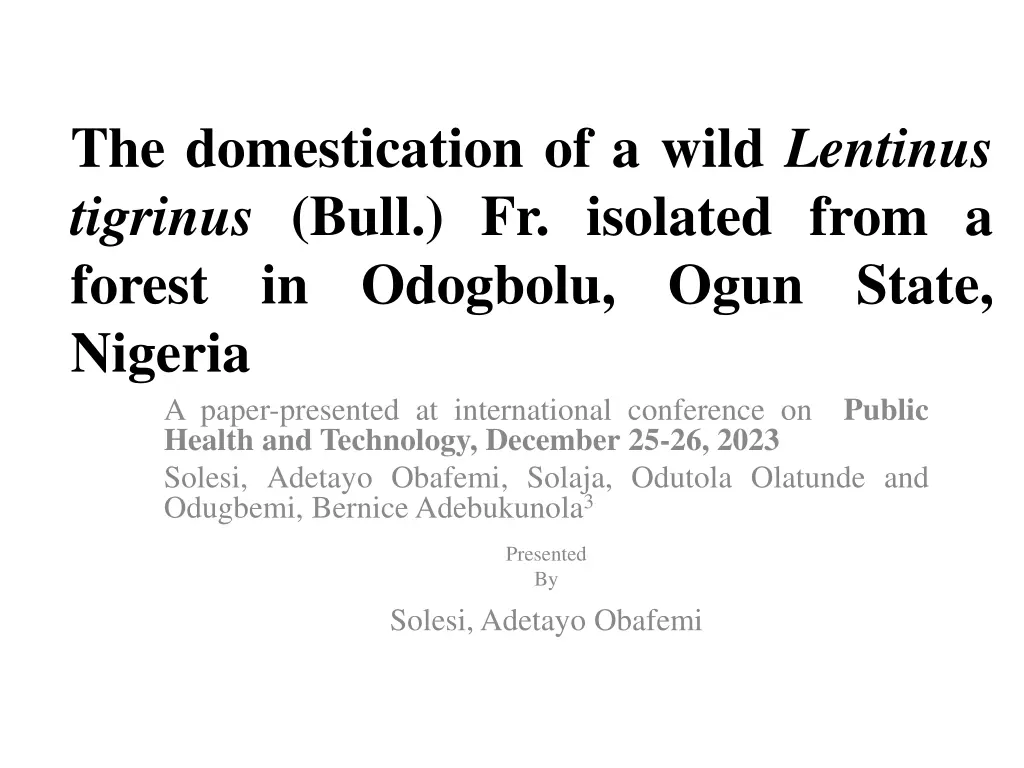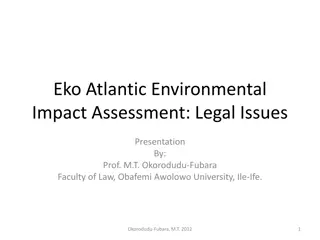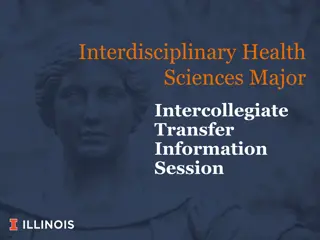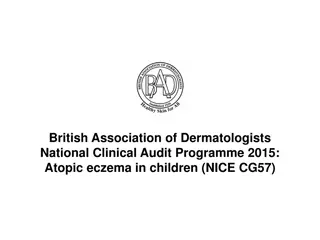
Domestication of Wild Lentinus tigrinus: Health Benefits & Cultivation
Explore the domestication process of wild Lentinus tigrinus mushrooms from a forest in Nigeria, focusing on their health benefits and cultivation techniques using locally available substrates. Discover how this edible saprophytic mushroom is propagated, prepared for fructification, and harvested, offering insights into functional foods and nutritional properties. Presented at an international conference on Health and Technology, this study sheds light on the gourmet aspects of Lentinus tigrinus for potential health-conscious consumers.
Download Presentation

Please find below an Image/Link to download the presentation.
The content on the website is provided AS IS for your information and personal use only. It may not be sold, licensed, or shared on other websites without obtaining consent from the author. If you encounter any issues during the download, it is possible that the publisher has removed the file from their server.
You are allowed to download the files provided on this website for personal or commercial use, subject to the condition that they are used lawfully. All files are the property of their respective owners.
The content on the website is provided AS IS for your information and personal use only. It may not be sold, licensed, or shared on other websites without obtaining consent from the author.
E N D
Presentation Transcript
The domestication of a wild Lentinus tigrinus (Bull.) Fr. isolated from a forest in Odogbolu, Nigeria A paper-presented at international conference on Health and Technology, December 25-26, 2023 Solesi, Adetayo Obafemi, Solaja, Odutola Olatunde and Odugbemi, BerniceAdebukunola3 Ogun State, Public Presented By Solesi, Adetayo Obafemi
Mushrooms are one of the functional foods that possess health-related benefits with nutritional capacities; nowadays, functional foods have been increasingly gaining much interest from consumers with a keen interest in health, nutrition properties, and being able to protect from diseases (Kalac 2016; Abuajah , Ogbonna and Osuji 2015) Lentinus tigrinus, also referred to as tiger sawgill, is an edible saprophytic mushroom of the family Polyporaceae (MushroomExpert.Com, 2018; Dulay et al., 2014), a wood-rotting basidiomycete having leathery flesh, intense aroma and taste, qualifying it as a gourmet (Dulay et al., 2012). The study aimed at isolation and domestication of a wild edible strain of L. tigrinus and using locally available, and cheap agricultural wastes substrates.
METHODS AND MATERIALS Sample Collection Fruiting bodies of L. tigrinus were knife-plucked from the stumps and logs found in the same radius of the collecting site in Odogbolu, Ogun State, Nigeria, in September 2023. Mushroom samples were in a container wrapped with paper and transported to the laboratory for further use: identity authentication with available literature, identification Application software and pictorial guides. Mycelium Propagations The tissue culturing using standard methods by Stamets, 2000 and Oie, 2016; some tissues of the samples (wild strains) were aseptically picked from the fruiting body using a sterile scalpel and cultured in Petri dishes with Potato Dextrose Agar media for 3-5 days in the dark at room temperature. Pure cultures of the mycelium were further sub-cultured and kept for further use. Spawn Culture Preparation The pure culture of the mycelium from the wild strain was used for the spawn production, using sorghum grains (sorghum bicolor) that were washed and boiled for 10 min and drained until no more drop as the substrate and inoculated with mycelium wedge of colonized PDA, incubated for 15 days until fully ramified the polyethene bag.
Substrates Preparation The dry maize straws were clean, air-dried and powdered; the sawdust was neat and kept until further use. Five bags of each sole substrate that is maize straw and sawdust only, five bags of ratio 1:1 mixture of maize straw and sawdust prepared. One hundred grams of each of the three substrates preparations- added with 10% wheat bran and 1% grounded charcoal and packed in polyethylene bags, pasteurized for 4 hr in a metal barrel. Spawn Running The fifteen (15) pasteurized substrate bags with the size of 15 cm x 25.5 cm were allowed to cool until the next day before being inoculated with the spawn grains and incubated at 25 humidity being maintained at 80- 85% by using knapsack to spray water at two hourly during the daytime from 8:00 am to 6:00 pm for 25 days until fully colonized in the dark. Fructification and Harvesting The fully colonized cylindrical-shaped polyethene bags were randomly cut at multiple points by the sides intermittently sprayed with water for pin-head formation until fully grown fruiting bodies emerged at the first flush, and repeatedly sprayed till the third flush when the biomass became small. The matured clusters of fruiting bodies were harvested and weighed at each flush until the third flush.
Biological Yields / Biological Efficiencies The biological yields of the three substrates were measuring the weight of the clusters of the flushes from each substrate treatment. And the biological efficiency was measuring the percentage ratio of the Biological yields to the dry weight of the substrates. Using the formula; Biological efficiency % = (weight of fresh mushroom fruiting bodies/ weight of dry substrate) x 100.
RESULTS AND DISCUSSION Table 1, the fruiting bodies mass (n= 5; weight = g) per 100 g of substrates Substrates S/N Maize sawdust Mix of maize/ sawdust 1 51.20 55.61 57.3 2 52.54 56.90 58.25 3 49.95 53.31 56.72 4 50.45 54.95 55.85 5 50.63 53.63 60.20 Total 254.77 274.4 288.32
Total biological yields. The total biological yield is the sum of the clusters from each growth bag divided by the no of bags. The biological efficiency The Biological efficiency is the percentage ratio of the biological weight to the weight of the substrate, using the formula; Biological efficiency = (biological weight/substrate weight) x 100 For maize; (254.77/500) x 100 = 50.95%; For sawdust; (274.4/ 500) x 100 = 54.88%; For 1/:1 mix; (288.32/500) = 57.66%.
DISCUSSION The Mushroom cultivation is the ability to turn agricultural wastes to more needed by- products, employing tissue cloning technology. These agricultural wastes mostly resulted in creating ecosystem problems (Adedokun and Okomadu, 2016). In this study, it was observed that the two substrates and their mix were able to convert the mushroom tissue used to fruiting bodies. The biological yields increasingly range from maize straw to sawdust and to the mix of the two. The equal mix of maize straw and sawdust optimizes the growth yield as indicated in this study. The Biological efficiency (BE), the yields of Lentinus tigrinus are ranged from 51% - 58% which were more than yield of 21.36% and 39.77% for P. citrinopileatus cultivated on rice straw and bean straw respectively by Musieba et al. (2012). And, more than the yield recorded by Adesina et al. (2011) that accounted for a yield of 20.5% for L. squarrosulus cultivated on Spondias mombin supplemented with rice bran.
REFERENCES Abuajah, C. I., Ogbonna, A. C. and Osuji, C. M. (2015). Functional components and medicinal properties of food: a review, Journal of Food Science and Technology, vol. 52, no. 5, pp. 2522 2529. Adedokun, O.M. and Okomadu, C.A. (2016). Wild and domesticated mushroom consumption in Nigeria. African Crop Science Journal, Vol. 25, No. 1, pp. 123 131 Adesina, F.C., Fasidi,I.O. and Adenipekun, C.O. (2011). Cultivation and fruit body production of Lentinus squarrosulus Mont. (Singer) on bark and leaves of fruit trees supplemented with agricultural waste. Afr. J. Biotechnol. 10(22): 4608-4611. Dulay, R. M. R., Cabrera, E. C., Kalaw, S. P. and Reyes, R. G. (2012). Optimal growth conditions for basidiospore germination and morphogenesis of Philippine wild strain of Lentinus tigrinus (Bull.) Fr., Mycosphere, vol. 3, no. 6, pp. 926 933.
REFERENCES cont. Dulay, R.M, Arenas, M.C, Kalaw, S.P, Reyes, R.G, and Cabrera, E.C. (2014). Proximate composition and functionality of the culinary-medicinal tiger sawgill mushroom, Lentinus tigrinus (higher Basidiomycetes), from the Philippines. Int J Med Mushrooms, 16(1):85-94. Kalac, P. (2016). Edible Mushrooms, Chemical Composition and Nutritional Value, Academic Press, Cambridge, MA, USA, 1st edition, (MushroomExpert.Com). Lentinus tigrinus Downloaded from www.mushroomexpert.com Major Groups Gilled Mushrooms Pale-Sporedon March. 2018. Musieba, F., Okoth, S., Mibey, R.K., Wanjiku, S. and Moraa, K. (2012). Suitability of locally available substrates for cultivation of the Kenyan indigenous golden oyster mushroom (Pleurotus citrinopileatus Singer). Am. J. Food Technol. 7(10): 650- 655 Oei, P. (2016). Mushroom cultivation IVAppropriate technology for mushroom growers. Eco Consult Foundation, The Netherlands, 520 p. Stamets, P. (2000). Growing gourmet and medicinal mushrooms, Ten Speed Press, California, USA. 574p.
Thank You For you Attention





















